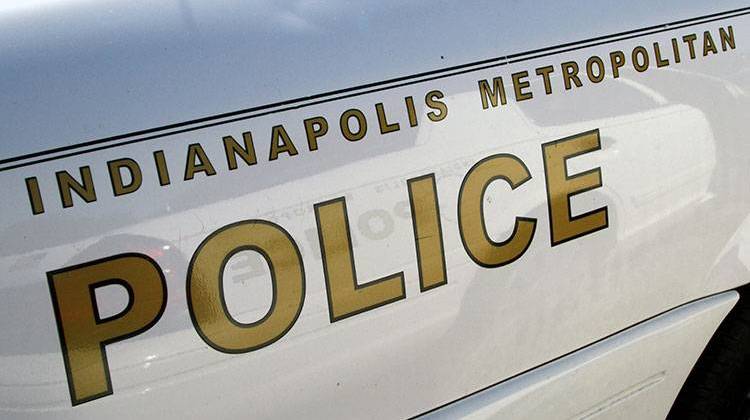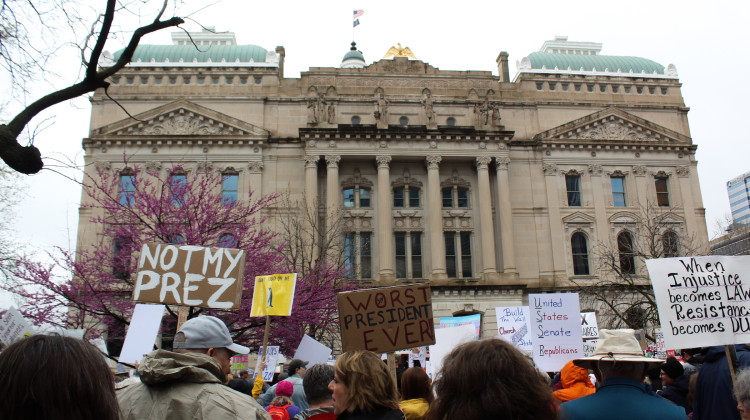
When VirSarah Davis’ 10-year-old son was released from detention, she thought it was the end of the ordeal for their family. But he was in and out of detention and commitment for almost a decade.
Dylan Peers McCoy/WFYIVirSarah Davis’ son was held in juvenile detention so many times the reasons blur together in her memory. He had an “outburst” at school. He was caught with a gun. He fled house arrest.
But she knows one thing for certain: He was 10 years old the first time police took him from their home in South Bend to detention.
“He just kept saying, 'that's a scary place,’” said Davis, who thought the ordeal was over when the court released him 15 days later. Instead, she now says, “it was just the beginning for us.”
Indiana detains and commits youth at a rate that’s about 40 percent above the national average. That’s higher than almost every state in the Midwest, according to a one-day federal count before the coronavirus pandemic. These young people are held in county detention before judges decide their cases. They’re removed from their homes for residential treatment at private facilities. And they’re committed to state correctional facilities.
It’s a problem that has caught the attention of state leaders, and the legislature made some changes to youth detention policies earlier this year. But it remains unclear whether lawmakers have an appetite for further reforms.
During the eight years Davis’ son was in and out of detention, treatment and state facilities, his mother said he was different whenever he came home. And he often behaved like he was still there: He would ask permission to open the fridge and take a soda. He’d wear rubber shoes in the shower.
“I feel like my son is becoming institutionalized,” Davis said.
 The consequences of detention and commitment can be dire for children and teens. Research on juvenile incarceration has found that when youth are locked up, they are less likely to graduate from high school and it can increase the risk of recidivism.
The consequences of detention and commitment can be dire for children and teens. Research on juvenile incarceration has found that when youth are locked up, they are less likely to graduate from high school and it can increase the risk of recidivism.
“The justice system imposes its own trauma,” said JauNae Hanger, executive director of the Children’s Policy and Law Initiative of Indiana. “Anytime you take a child into a locked situation, you're going to be imposing, potentially, more harm.”
In Indiana, Black youth are more than 2 1/2 times as likely to be detained and 3 1/2 times as likely to be committed to the state compared to their White peers. The disparity is even larger nationally.
Across the country, growing awareness of those problems and declining juvenile arrests helped spur a dramatic national drop in youth incarceration beginning in the late-1990s. Detention and commitment in Indiana has also declined. While the state locks up fewer youth than it used to, it has made less progress than others.
Only a small number of children and teens are incarcerated, and state data is limited. But the federal government has conducted a single-day count of youth in detention and commitment since 1997. The 2019 census, which is the latest available, found that Indiana locked up about 1,200 children and teens. That’s more than states with substantially higher populations — including Illinois and New York.
Why Hoosier youth are detained
Some Indiana lawmakers, court officials and advocates are paying attention. Last year, a state task force released recommendations for reforming the juvenile justice system. They included some policy changes the legislature has already adopted, such as limiting confinement of children under 12 years old and requiring counties to use risk assessments to determine if a juvenile needs to be locked up.
The state’s progress is positive, Hanger said. But she and other advocates believe Indiana needs to take more aggressive steps.
“It's really time for us to take a step back and say structurally, what do we need to do differently?” Hanger said. “Where do the laws in this state actually lead to the criminalization of youth?”
So far, Indiana has largely relied on local communities to reduce youth incarceration.
Prosecutors, police and courts decide what to do when young people break the law. Some of them, like the Marion County system, have prioritized alternatives to youth detention — and significantly reduced the number of children and teens in holding. Many other counties, however, locked up children and teens at the same rate in 2019 as they did in 2016, according to an analysis commissioned by the state reform task force.
Advocates say Indiana courts detain many children and teens who should remain in the community. The majority of youth detained before trial are accused of misdemeanor offenses. That includes non-violent crimes like theft, possession of marijuana and disorderly conduct. Some children and teens are detained for status offenses, which would not be crimes if they were adults, such as running away and missing school.
“There is no therapeutic value for a 10-year-old who's in a detention center — or for a 13-year-old who's in a detention center. There's just none,” said Liz Manley, a senior advisor for health and behavioral health policy at the University of Maryland.
Manley previously served as assistant commissioner for New Jersey’s Children's System of Care. That state uses mobile response and stabilization teams to intervene when children are in crisis. The teams connect families with immediate help that aims to keep youth in their own homes and community. In some cases, those teams get young people into inpatient care.
“There are plenty of interventions that can be in place to prevent that young person from touching on a detention center — in particular, when it's a non-violent offense,” Manley said.

In Indiana, youth detainment is “the bottom of your safety net”
Davis and her son live in South Bend, where the St. Joseph County Probate Court handles juvenile cases.
The St. Joseph County Juvenile Justice Center — where Davis’ son was held — faced a lawsuit in 2017 over the use of solitary confinement. It claimed the facility held an 11-year-old boy alone for periods of 23 hours for days at a time. The suit was settled in 2019.
Executive Director Bill Bruinsma, who took over that year, helped draft the settlement. He said it made improvements to the facility’s environment and staffing levels. Now, he said the ratio of staff to youth is four-to-one instead of eight-to-one.
Youth may only be restricted to rooms when they pose a risk to themselves or others, and staff must reassess the risk every 15 minutes, under the settlement. Bruinsma said the facility also overhauled staff training and practices to focus on trauma informed care.
“We've made a big change in culture,” said Bruinsma, a psychologist who has worked in juvenile justice for close to three decades.
The number of youth held at the juvenile justice center has declined in recent years. Bruinsma said that now, only the highest risk youth are detained or committed.
Bruinsma argued that detaining some young people is essential for community safety and for those youth.
“In Indiana, the juvenile system in every county is the bottom of your safety net,” Bruinsma said. “So when the schools fail, and the parents fail, and the medical systems fail, and the mental health systems fail, guess who's handling it?”

Compared to other Indiana communities, St. Joseph County stands out because it sends significantly more youth to the state juvenile correction center. Over the five years, the only place that has sent more young people to state holding is Marion County. That’s the state’s largest county, and it has more than three times as many youth between 10 and 19 years old than St. Joseph County.
Over the last five years, the number of youth St. Joseph committed to the state has ranged from 21 to 68 annually.
Bruinsma said only a tiny fraction of the youth who go through the St. Joseph Court are committed to the state, and it is an important treatment option in some serious cases.
If communities stop detaining and committing young people in serious need, Bruinsma said, those juveniles could eventually face even more devastating consequences. He pointed to deadly gun violence in South Bend and other Indiana cities.
“It's not a benefit to the child,” Bruinsma said. “If I put him back in a situation where it's totally unsafe for him, you know, and he's killed. That's a disaster from my viewpoint.”
That’s a fear South Bend mother Davis shares. But Davis said instead of helping her son, detention made things worse. He was arrested at 17 for gun-related offenses and charged as an adult. He is currently held in county jail awaiting sentencing.
“He's gonna start his adult life with a felony,” Davis said. It “pretty much shattered a lot of stuff for us.”
Davis believes the eight years her son spent in the juvenile justice system set him up to start his adult life in jail.
CLARIFICATION (Nov. 16, 2022): This story has been updated to clarify that Davis’ son is currently held in county jail. He is not in prison.
Contact WFYI education reporter Dylan Peers McCoy at dmccoy@wfyi.org. Follow on Twitter: @dylanpmccoy.
Contact WFYI criminal justice reporter Katrina Pross at kpross@wfyi.org. Follow on Twitter: @katrina_pross.
Pross is a Corps Member of Report for America, an initiative of The GroundTruth Project.
 DONATE
DONATE






 Support WFYI. We can't do it without you.
Support WFYI. We can't do it without you.